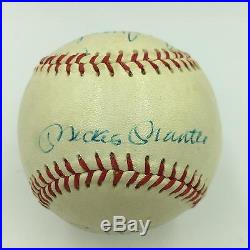

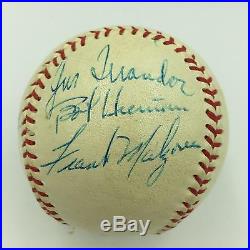
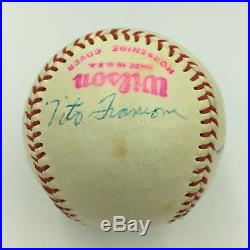
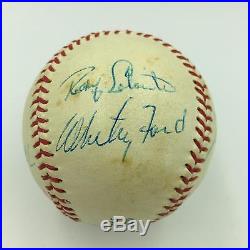
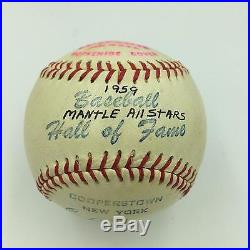
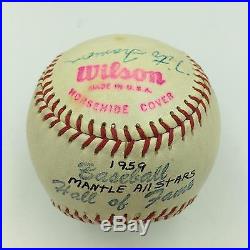
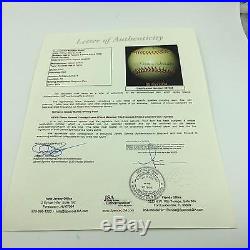

Rare 1959 Mickey Mantle “Mantle All Stars” Home Run Derby Signed Baseball JSA. Rare 1959 “Mantle All Stars” Home Run Derby Multi Signed Baseball with signatures from Mickey Mantle (beautiful sweet spot mint signature), Elston Howard, Whitey Ford, Harvey Kuenn, Rocky Colavito and others. Comes with full letter COA from JSA. Is a 1960 television show. That was held at Wrigley Field in Los Angeles. Pitting the top sluggers of Major League Baseball. Against each other in nine-inning home run. The show was produced and hosted by actor/broadcaster Mark Scott. And distributed by Ziv Television Programs. Filmed in December 1959. The series aired in syndication from January 9 to July 2, 1960, and helped inspire the Home Run Derby. Event that is now held the day before the annual Major League Baseball All-Star Game. Staged a revival of the show in 1989. The rules were similar to modern home run derbies, with two notable exceptions. If a batter did not swing at a pitch that was in the strike zone, that also constituted an out. Also, the contests were conducted in a fashion more similar to a baseball game than the modern home run derbies, in which a player has a set number of outs before his turn is over. Batters were given three outs per inning, and the player with the most home runs after nine innings won. The defending champion had the advantage of batting last; his opponent batted first. Any ball not hit for a home run was an out. The player did not have to swing at every pitch, but if a pitch was in the strike zone. That also constituted an out, as did a swing and a miss. These rarely happened as the pitcher was supposed to give the batters good balls to hit. If the players were tied after nine innings, the Derby went into extra innings as per regular baseball. When a left-handed hitter played, a special rule was put into place. Wrigley Field in Los Angeles had an inner fence with palm trees and a brick wall located several feet behind it. Any pitch hit in that direction had to clear the wall or hit the top of the trees that stuck out over the wall to count as a home run. This was done because the distance was shorter to right field with the inner fence, which would otherwise give a lefty an unfair advantage. The distances were still slightly different once the deeper right field wall was factored in, but at 339 feet vs. 340 feet the difference was negligible. While one player was taking his turn at bat, the other player would sit at the host’s booth and have a brief conversation, typically unrehearsed small talk about the contest itself or the player’s performance that season. Scott took him up on it, speaking into the microphone. Similar to a bowling. Announcer, whenever Mays stepped up to the plate. Sometimes when the batter hit a ball into the deep outfield, the player in the booth would comment that it would have gone for extra bases in a real game, to which Scott replied that on. It’s nothing but an out. Some players wore golf gloves during the show – a notable addition because the batting glove was still years away from being a normal part of a player’s gear. Hank Aaron, 6-time winner on the show. Mickey Mantle, who hit the most home runs on the show. Nineteen players, including nine future members of the Baseball Hall of Fame. Participated in the series almost all the power hitters. Elected to the Baseball Hall of Fame. With the death of Bob Cerv on April 6, 2017, five of the participants are still alive: Aaron, Colavito, Kaline, Mays, and Robinson. One pitcher for the show was former major leaguer Tom Saffell. And the catcher was minor leaguer John VanOrnum. Later a San Francisco Giants. A former American League. Umpire who would go on to a TV acting career, served as the plate umpire. There were also umpires along both foul lines to help judge fly balls that were close calls. Scott noted that Wrigley Field. In Los Angeles was chosen to host the event because its fence distances were symmetrical, favoring neither right-handed nor left-handed hitters. Despite Scott’s assertions, the left field wall was actually a few feet higher than the right field wall, which slightly penalized right-handed line-drive hitters such as Gus Triandos. The Los Angeles Dodgers. Played at the Memorial Coliseum. During 19581961, a site that would have given an unfair advantage to right-handed batters. Each show would end with the host presenting each player with their prize checks (beginning with the loser), and would award separate checks for consecutive home run bonuses. These were actual bank checks, not the jumbo “display” checks typically used today. As an incentive for throwing good home-run-hitting balls, the pitcher who threw the most pitches for home runs also received a bonus, according to the host. Unlike more modern home run derbies, which usually award prizes in the form of donations to a player’s choice of charity, the economic realities of the era meant that the cash prizes earned by the players on the show were a substantial income supplement. The most home runs in a derby was 25, in the Jackie Jensen vs. Ernie Banks contest (1411), while the fewest was 4, in the Hank Aaron vs. Duke Snider contest (31). Jensen’s 14 home runs against Banks were the most a player hit in a single contest. Only one home run was recorded in a contest three times; by Snider, Al Kaline, and Gus Triandos. Mickey Mantle hit the most home runs on the show, a total of 44 during his five appearances. Aaron had the best overall record at 61, while Rocky Colavito and Jim Lemon were each 02. Jensen was the only player to hit four and subsequently five home runs in a row, doing so in the fourth inning of the final episode. Snider and Eddie Mathews and were the only left-handed batters to compete. Switch-hitter Mantle batted right-handed in the contests; he hit 372 homers left-handed in his career and only 164 right-handed, but he chose to bat exclusively right-handed for this series, commenting in the first episode that his longest home runs had come right-handed. Triandos was the only catcher. To participate on the program; despite never hitting more than 30 home runs in a season and ending his career with 167 home runs, he was chosen because he was the best power-hitting catcher in the major leagues at the time. He also took until the seventh inning to hit his first home run, the longest such drought in a contest, and just surpassing Snider, who hit a home run off the trees in the sixth inning of his contest vs. Triandos was nonetheless good-natured, treating his futility with a mix of self-deprecation and humorous sarcasm, and wishing Dick Stuart luck after their competition. We specialize in sports autographs and memorabilia. We have one of the largest selections of baseball autographs in the country. The item “Rare 1959 Mickey Mantle Mantle All Stars Home Run Derby Signed Baseball JSA” is in sale since Tuesday, May 02, 2017. This item is in the category “Sports Mem, Cards & Fan Shop\Autographs-Original\Baseball-MLB\Balls”. The seller is “showpiecessports” and is located in Deal, New Jersey. This item can be shipped to United States.
- Autograph Authentication: James Spence (JSA)
Tags: baseball, derby, home, mantle, mickey, rare, signed, stars




 If you like this post and would like to receive updates from this blog, please subscribe our feed.
If you like this post and would like to receive updates from this blog, please subscribe our feed.
